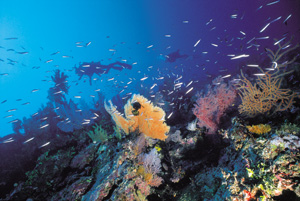The Great Barrier Reef
The Great Barrier Reef, considered to be one of the Seven Natural Wonders of the World, is a holiday highlight for many international and Australian tourists alike.
The World Heritage listed reef is home to over 3,000 reef systems ranging from 1 hectare to over 10,000 hectares in area, 600 islands, stretches over 3,000km of the Queensland coast line and is a huge 300,000 square kilometres (approx) in size, making the Great Barrier Reef the largest reef system in the world.
There's no surprise then that over 2 million people flock to the Great Barrier Reef each year, generating more that $AU2 billion dollars in tourism for Australia.
We've included some interesting information about the reef below, but if you're more interested in seeing the Great Barrier Reef, have a look through our Picture Tour, or book a cruise, dive or scenic flight over the spectacular reef. Don't forget to book your Great Barrier Reef accommodation.
History of the Great Barrier Reef
 The Great Barrier Reef has a very long history indeed - the GreatBarrierReef.org website has some great information on the reef's history, including the formation and discovery of the Great Barrier Reef, for those wanting to know a little more behind the tourist attraction.
The Great Barrier Reef has a very long history indeed - the GreatBarrierReef.org website has some great information on the reef's history, including the formation and discovery of the Great Barrier Reef, for those wanting to know a little more behind the tourist attraction.
It's widely accepted that the French provided the earliest documentation of the reef in the latter half of the 1700's, however it was Captain James Cook who sailed the length of the Great Barrier Reef in 1770, and even had to spend six weeks repairing the Endeavour after it had struck the reef on June 11.
In 1975, the Australian Government brought the Great Barrier Reef Marine Park Act into place, which ultimately created the Great Barrier Reef Marine Park Authority (GBRMPA) that regulates commercial and environmental activity along the reef while ensuring sustainable practices are carried out.
For roughly 40,000 years, the Aboriginal and Torres Strait Islander communities have fished and hunted in the waters of the reef, and the Marine Park Authority has recognised the need for protection of cultural and heritage values that are held by Indigenous Australians, and since 2004, has been working alongside these communities in relation to the traditional use of the reef and it's resources.
In 1981, the Great Barrier Reef was declared a World Heritage area, and was included in the National Heritage list in 2007.
Great Barrier Reef Marine Park Authority
The majority of the Great Barrier Reef is part of the Great Barrier Reef Marine Park (which is governed by the GBRMPA). The Marine Park Authority alongside the Environmental Protection Agency (EPA) have introduced a range of marine park management tools including permits, zoning areas and identification systems that still cater for tourism opportunities and activities while reducing the environmental impact tourism can have on the reef.
The Great Barrier Reef Ecosystem
Perhaps one of the most impressive facts about the Great Barrier Reef is the number of living organisms the reef provides a habitat for. The diversity of life - most of which are endangered or vulnerable - in the reef is one of the primary reasons for the establishment of the Great Barrier Reef Marine Park Act . Some interesting facts about the marine life in the reef are below:
Ecosystem Facts & Figures
 Over 30 species of whales, dolphins, porpoises have been recorded in the reef, with a large dugong population evident in the waters
Over 30 species of whales, dolphins, porpoises have been recorded in the reef, with a large dugong population evident in the waters- 6 species of sea turtles breed in the reef - the green, leatherback, hawksbill, loggerhead, flatback and olive ridley sea turtles
- There are 15 species of seagrass in the reef - which helps to attract the dugongs, sea turtles and fish
- Over 125 species of sharks, stingrays and skates live on the reef
- Nearly 5,000 species of mollusc have been recorded on the reef, including the giant clam
- 1,500 species of fish live in the reef
- Over 400 species of coral, and over 500 species of marine algae or seaweed live on the reef
- 49 species of pipefish and 9 species of seahorse are present in the reef
- Over 7 seven species of frogs and 215 bird species inhabit the islands in the reef, which are also known to support over 2,000 plant species
Other Interesting Facts & Figures
- The Great Barrier Reef is the world's largest reef system
- It is larger than the Great Wall of China, and is the only living thing on Earth that can be seen from space
- There are over 500 commercial boats that bring tourists to the region
- The Reef brings over 2 million visitors to the region each year, generating a whopping $AU2 billion of tourism dollars
More Information
Visit these sites for more information about the Great Barrier Reef.
- GreatBarrierReef.org - a site dedicated to the GBR, providing detailed information about the reef including history, accommodation and geography.
- Tourism Port Douglas Daintree - the official tourism website of the Port Douglas region & the Great Barrier Reef
- Great Barrier Reef Marine Park Authority - the regulatory body that overseas commercial and environmental activity







